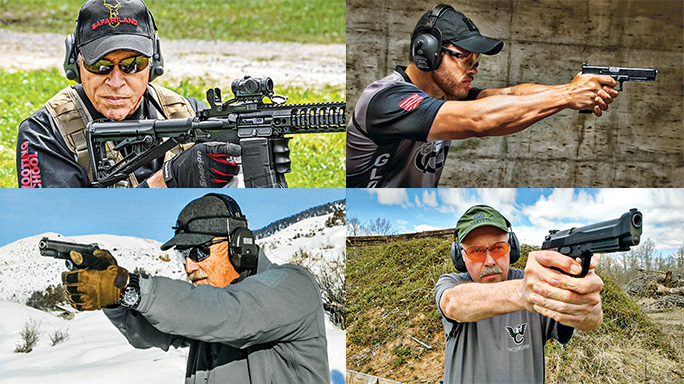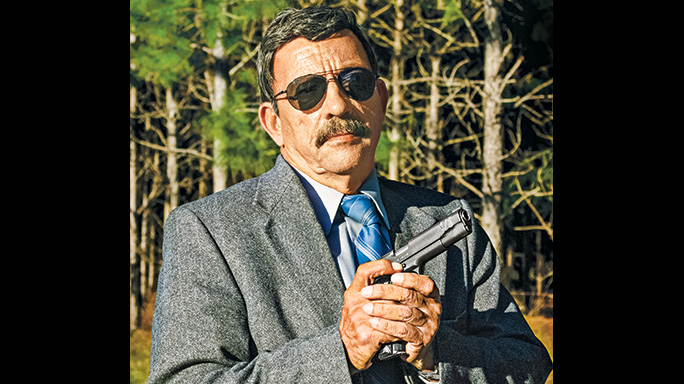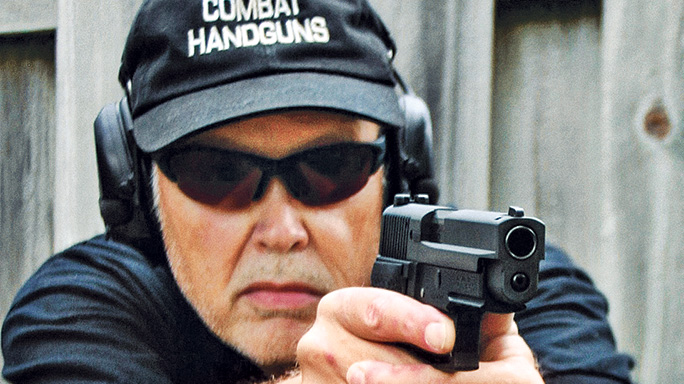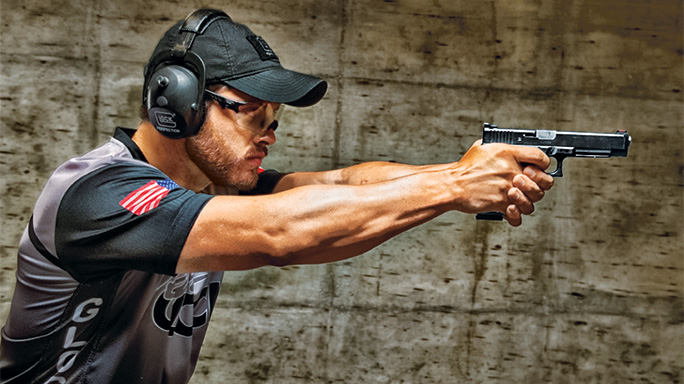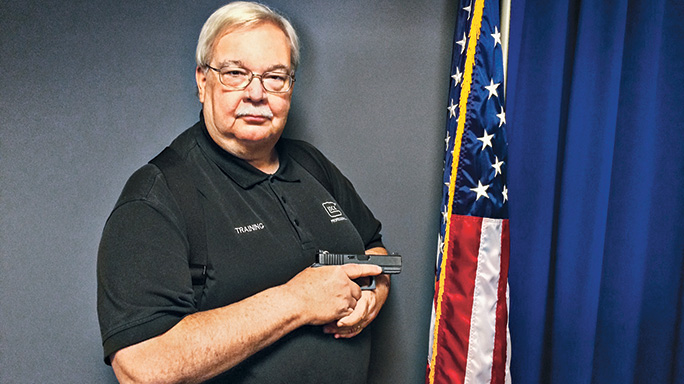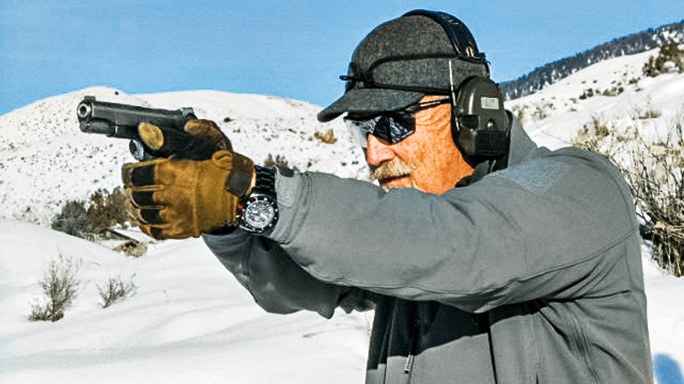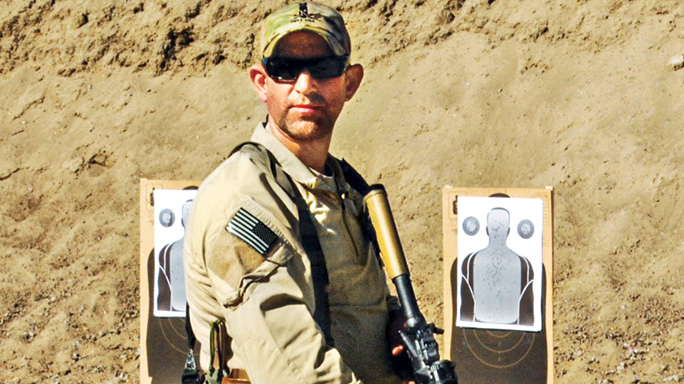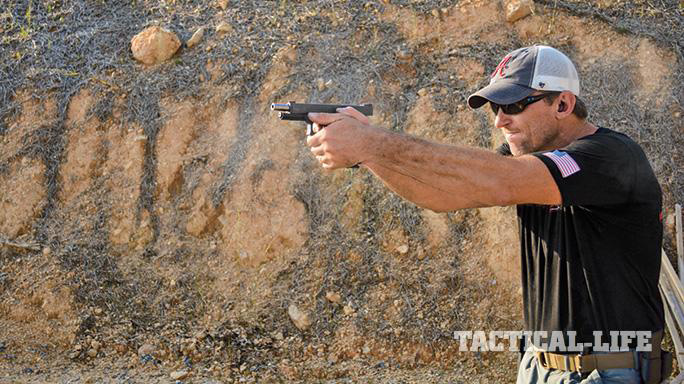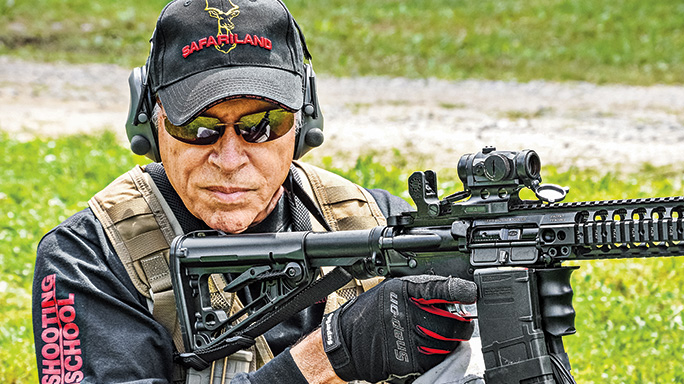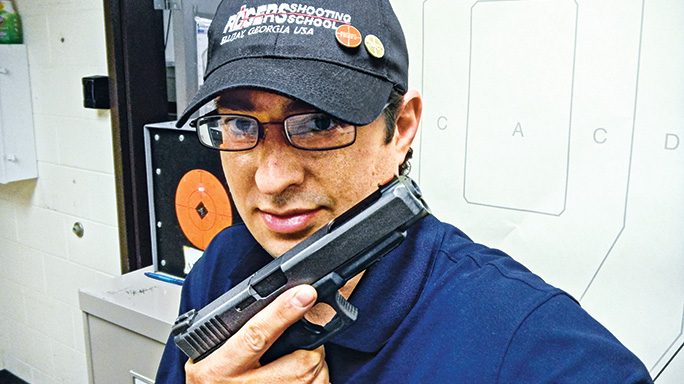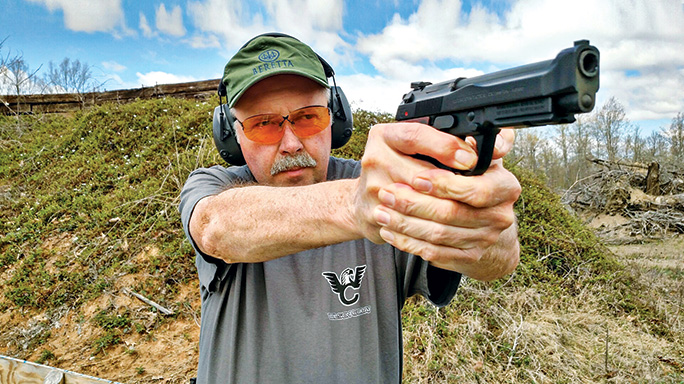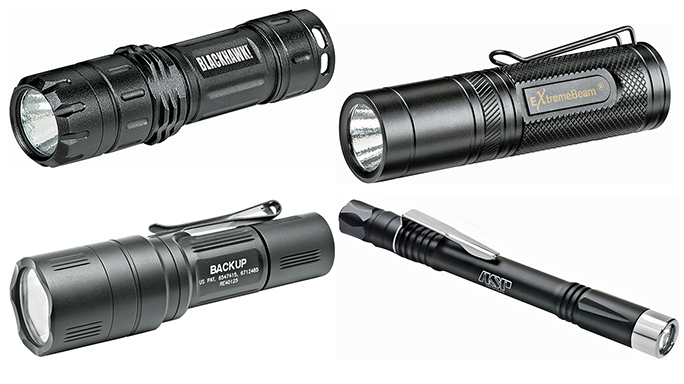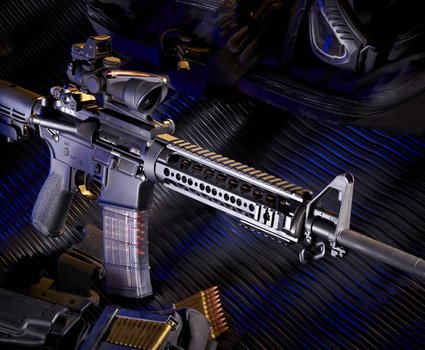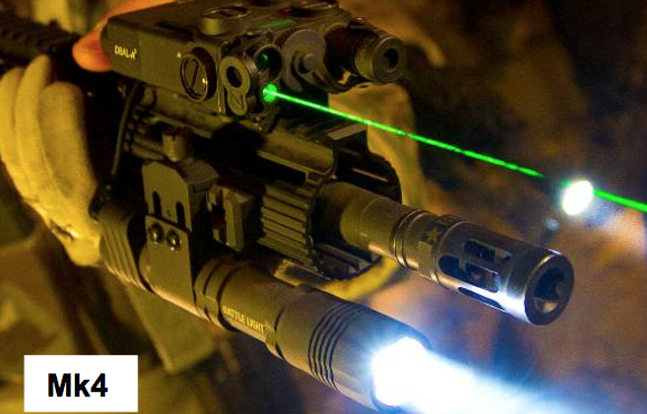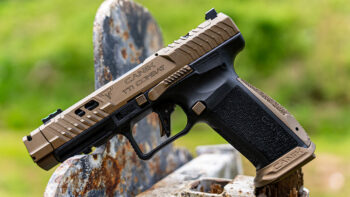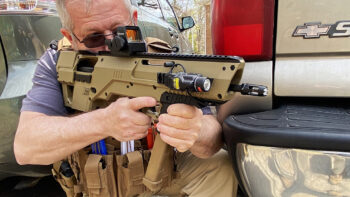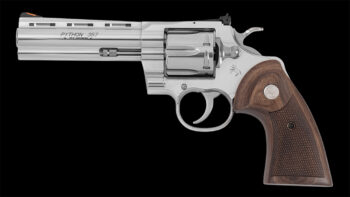Article also compiled by John Naderi.
A decade ago, there were seemingly very clear lines drawn between competition and tactical shooters. On one side, you had men and women in tight spandex shirts with logos plastered all over them and on the other, shooters clad in nothing but camo and Velcro. The two groups rarely mixed, and when they did, you got a heated debate about the merits of one shooting discipline over the other.
- RELATED STORY: 7 Experts Discuss Their Precision Caliber of Choice
Some say competition-style shooting places the shooter in unrealistic situations and that it can teach dangerous habits. They insist that competition should not be used as a form of defensive training. Others say competitive shooting enhances important shooting and gun-handling skills and is a great way to maintain shooting proficiency.
Taking a look at current guns and gear trends, it looks like these two worlds have merged in recent years. We’re now seeing what were once the trademarks of competitive shooting, such as red dots and long slides on pistols, making their way over to the tactical and defensive side.
- RELATED STORY: 18 Experts Pick Their Concealed Carry Weapon of Choice
But how does competitive shooting affect real-world defensive shooting scenarios? In this Round Table installment, we ask the experts, “Do the skills learned from competition shooting translate to defensive scenarios, or do you think it’s best to not to mix these shooting disciplines?”
Ballistic’s Round Table is a varied panel of competition shooters, tactical trainers and former military and law enforcement personnel with invaluable experience to share. The opinions of this diverse group of seasoned experts are meant to create debate and encourage further discussion.
MASSAD AYOOB
- Affiliation: Massad Ayoob Group
- Position: Director and trainer
- Do you think competitive shooting affects real-world defensive-shooting scenarios? Yes, for the better.
Why? Competition makes shooting under pressure the norm. Wyatt Earp shot in the informal cow-town matches of his day. In the 20th century, Jelly Bryce was a pistol match winner before he became a cop. Jim Cirillo and Bill Allard of the famed NYPD Stakeout Squad were winning competitions before they became famous for winning shootouts. Col. Charles Askins, Jr. and Kerry Hile in law enforcement, and from Alvin York to Carlos Hathcock in the military … the list goes on.
WILLIAM BELL
- Affiliation: U.S. Customs & Border Protection
- Position: Retired CBP officer and instructor
- Do you think competitive shooting affects real-world defensive-shooting scenarios? Yes.
Why? I have been shooting competitively as an Army National Guard officer and law enforcement officer (LEO) for over 38 years and have found that other than force-on-force training using Simunition, shooting competitively provides a certain amount of stress that one doesn’t normally experience in target practice or even during standard LE qualification courses. Competitive shooting builds confidence and results in additional practice than might otherwise not be experienced. This leads to more familiarity with the firearm, so that if there is a weapons-related mishap, the user will have the know-how and “muscle memory” needed to immediately resolve it. Intense practice increases your accuracy, heightens your performance and reduces your reaction time.
Sure, there are aspects of competitive shooting that could be counterproductive to “real world” situations, such as firing out in the open or shooting for speed in place of accuracy. But, sadly, lots of the LE training I’ve seen isn’t much better, as tactics are secondary to qualifying. I think the LEO or legally armed citizen who uses competition for training needs to separate fact from fantasy and decide if they want to win competitions or maybe save a life. If choosing to use the proper tactics causes you to lose some points, so be it. I for one believe my years of competitive shooting were a plus in my efforts to survive on the streets. I’m able to draw my handgun and get off effective shots rapidly, but I also realize it’s on me to train using tactics not covered in competition. If you are serious about shooting to survive, then I think you have enough intelligence to translate what you learn in competition into practical skills for your training toolbox so, if necessary, you can go into action instead of hesitating.
SHANE COLEY
- Affiliation: Team Glock
- Position: Captain
- Do you think competitive shooting affects real-world defensive-shooting scenarios? Yes.
Why? Competitive shooting teaches you how to manipulate your firearm efficiently and effectively at high rates of speed under certain levels of stress not encountered during normal training sessions. We are able to quickly adjust our focal points between targets while still seeing a clear front sight. We are able to put fast and effective shots on target while continuously maintaining proper trigger control, and we are constantly shooting on the move while maintaining a stable shooting platform. Of course, I will not enter a defensive situation with my competition rig, so I still train with my carry pistol on a regular basis, but the skills I learn from my everyday competition will continue to prepare me for any defensive situation I might find myself in where I have to move quickly and put effective shots on target. Many combat veterans and law enforcement personnel have now ventured into the world of competition because it increases their skill set on the battlefield by teaching them speed, efficiency and how to think quickly on their feet. Competitive shooting makes me a better shooter as a whole, which in turn makes me more prepared and more effective.
CHRIS EDWARDS
- Affiliation: Glock, Inc.
- Positions: Firearms instructor, GSSF range master/match coordinator
- Do you think competitive shooting affects real-world defensive-shooting scenarios? Absolutely.
Why? My involvement with competition shooting began over 35 years ago, when, after my first defensive handgun course with John Farnam, I asked what would be a good way to keep my recently acquired skills sharp. John, a follower of Col. Jeff Cooper, said, “Well, there’s this new thing called IPSC.” Since then, I’ve participated in IPSC, USPSA, Steel Challenge, PPC and IDPA and had a hand in getting the GSSF started. I’ve been fortunate enough to receive instruction and training from many respected schools, like Gunsite, Thunder Ranch, the Rogers Shooting School and NRA LE programs. Along with Farnam, I’ve been instructed by Ken Hackathorn, Todd Green, David Blinder, Scotty Reitz, Jeff Gonzales, Michael de Bethancourt, Walt Rauch, Massad Ayoob and privileged to work with Glock instructors and current and recently retired members of the U.S. military’s special operations community. The vast majority of all these good folks have been or are still involved in some form of “practical/action” shooting. In my deputy sheriff days, we would have recognized that as a clue.
Speaking of being a deputy sheriff, I am convinced that my competing improved my shooting, which bolstered my confidence; I was better at my job because of that confidence. Many of the early 20th century gunfighters participated in or started out in competitive shooting—Askins, Bryce, Cirillo and Walsh to name just a few. And recent 21st century warfighters like Harrington, Lamb, Parent and Proctor shoot/have shot competitively—there’s that clue word again. Here’s the bottom line: Anytime you can get your gear, perform weapons manipulations, see your sights and work triggers in a controlled and safe environment, that’s called learning and experience, and those developed skills are going to be damn helpful should misfortune and evil come your way. Competition isn’t an end. It’s a means to the end of developing, testing and maintaining skills. I don’t “run and gun” as fast as I used to, but I still shoot in GSSF, IDPA and Steel Challenge matches to maintain my skills.
KEN HACKATHORN
- Affiliation: Alias Training & Security Services
- Position: Firearms trainer; retired U.S. Army Special Forces; Army, Gunsite, FBI-certified small arms instructor; retired deputy sheriff
- Do you think competitive shooting affects real-world defensive-shooting scenarios? Yes and no.
Why? Competition shooting has advantages in that it provides a format where individuals can learn to be very competent shooters. The accuracy and speed factors that they develop are both well documented. In my training classes, the best shooters almost always come from the ranks of IPSC/USPSA and IDPA. So, without question, competition provides really good skills.
The problem is that to become really good at competition, many mindset/tactics are disregarded. In fact, the real issue is that, like everything we do in life, “we are what we practice.” Engaging targets in the open when cover is close by, reloading on the run (though it’s much wiser to reload behind cover and then move), engaging targets in the order that gives us the fastest times instead of those that would be the greatest danger to the shooter, always having a chance to plan your “attack” or even rehearse your run—these are but a few of the things that set people up for failure in the real world. It appears that the more skilled you become in competition, the easier it is to preprogram behaviors that could be fatal in a real self-defense encounter.
- RELATED STORY: 8 Experts Pick Their Home Defense Weapon of Choice
It is my belief that situational awareness is far more important than marksmanship skills in the real world. You need to be good at combat marksmanship—it’s nice if you’re a great shot, but it’s rarely ever a requirement. Sadly, most top competition shooters delude themselves into believing that, because they are so fast and good, they will automatically win any fight they might get in. As soon as the targets start shooting back, “gameboys” will learn very quickly that the rules they live by on the range are much different than on the street.
On the other hand, naysayers who say, “Competition will get you killed on the street,” miss the mark in that they do not understand that the stress of competition can be an excellent learning device. Once you have learned to perform in competition and have reached a skill level you are confident in, you can begin to ask yourself, “What is it that the game offers me?” If game shooting is driven by the goal to be the best, you will likely acquire a mindset about doing well at the game without any appreciation of how badly you are setting yourself up for failure on the street when the learned behaviors from competition surface under life-and-death scenarios. As such, like many things in life, competition can be a great learning experience, but too much can be dangerous, kind of like alcohol consumption.
JOSH JACKSON
- Affiliation: LMS Defense
- Position: Director of operations and instructor; law enforcement patrol officer
- Do you think competitive shooting affects real-world defensive-shooting scenarios? Yes, in a positive way.
Why? In a tactical or defensive environment, your ability to perceive and interpret information faster will directly translate into an ability to make decisions in a compressed time frame. In competitive shooting, participants are required to make decisions in the fastest time possible in an effort to make the highest-value hits, or the most efficient hits. In my opinion, any opportunity to practice getting accurate first-round hits in a compressed time frame is of value for today’s shooters.
Competition requires the shooter to process information as the situation changes in front of you (moving, reactive targets, etc.). Having to make rapid decisions is invaluable training. Other benefits of competitive shooting that will translate to defensive applications include rapid and efficient weapons manipulations, smooth reloads and the ability to clear malfunctions under stress.
The cons of competition? Some are willing to forsake good tactics for points. I have seen police officers with a strong background in tactics forget all of that when they begin competitive shooting. I have then watched as their tactics began to degrade on the street. Specific issues include crowding cover, pushing weapons into areas not yet cleared and moving faster than the situation dictated. Additionally, the use of competition-based equipment can be contrary to the equipment used in self-defense or tactical applications.
A sound mix of defensive firearms training integrating shoot/no shoot targets, compressed time allowances and force-on-force training, coupled with competitive shooting, can only benefit the participant. Every shooter should identify and reevaluate their personal training goals on an ongoing basis. They should then seek out training to help them improve. Seek out information and training from a variety of sources to meet your specific needs.
FRANK PROCTOR
- Affiliation: Way of the Gun
- Position: Owner; USPSA Limited Division Grand Master; former Green Beret
- Do you think competitive shooting affects real-world defensive-shooting scenarios? Yes.
Why? From my own personal experience, I believe that competitive shooting will make a better tactical shooter. The skills necessary to win in competition can also help win in combat. I was a Green Beret for about three years before I started shooting competitively. I was absolutely the tactical shooter that said, “That stuff isn’t real. It’s a game. It doesn’t apply to combat,” etc.
But during my first USPSA match, I found out what I didn’t know about shooting. I wasn’t nearly as good as I thought I was, and I wanted to win, so I trained and competed more and learned more. Some of the skill sets I developed absolutely translate to tactical shooting, including extremely safe gun handling under very dynamic shooting situations, efficiency in movement and mechanics, and the ability to shoot and score hits on targets faster with more accountability. The greatest takeaway for me was more aggressiveness with my vision to see and process information faster. That skill set is key for tactical shooters, as they must see faster and see more in order to make faster decisions. After the decisions are made, then apply the shooting skills that were honed in competitive shooting. In my opinion, based on my experience, I encourage every tactical or defensive shooter to compete often.
BILL ROGERS
- Affiliation: The Rogers Shooting School, The Rogers Holster Company, The Safariland Group
- Position: Owner and chief instructor of the Rogers Shooting School; VP of new products for Safariland; former FBI agent; former USPSA VP and Area 6 director
- Do you think competitive shooting affects real-world defensive-shooting scenarios? Yes.
Why? The skills learned while participating in shooting competition certainly transfer to real-life scenarios. This is especially true when you look at shooting sports such as IDPA and USPSA. Learning to quickly and safely draw a handgun is a critical skill, as well as many of the other manipulation drills that are commonly learned. Engaging multiple targets quickly and sometimes while moving rapidly is another important skill for real-life situations. Probably one of the greatest skills acquired while competing is learning how to operate under pressure. I have seldom ever shot a match where I did not have an elevated heart rate, upper torso tremors, shallow breathing and difficulty focusing mentally.
GABE WHITE
- Affiliation: Public Safety Training Center
- Positions: Chief instructor, Public Range FTU
- Do you think competitive shooting affects real-world defensive-shooting scenarios? Yes!
Why? I think the skills tested in competition translate well to defensive shooting in many ways. Competition emphasizes accuracy and speed in shooting and gun handling, on-demand performance under stress and pressure, and making many small mental and physical adjustments while on the fly—all in the honest and open venue of a public contest. No competition accurately reflects the real-world issues of tactics and human interpersonal dynamics. Those cannot be accurately represented in a live-fire competition and must be addressed separately in tactical training. Bad habits can result from the exclusive practice of any activity, whether it’s an exclusive focus on competition or an exclusive focus on tactical training. We can make as big a list of potential training scars one can acquire from tactical training as from competitive shooting.
It is critical to use multiple types of training and adjunct activities—such as dry firing, live fire, force-on-force training, competition, etc.—as often as possible, or there will be holes in our skill sets. The potential downsides of competitive shooting are vastly overblown. Competitive shooting is particularly important because, for most people, it is one of the only circumstances available where there are repeated, legitimate opportunities to perform on demand and under stress. No single activity can give us everything we want or need. It’s important to utilize tactical training to develop our awareness, decision-making skills and tactics, and it can provide a solid foundation for shooting and gun handling, too. Competition is virtually a necessity if our technical skills are to be driven to the highest level possible.
BILL WILSON
- Affiliation: Wilson Combat, Circle WC Ranch
- Position: President
- Do you think competitive shooting affects real-world defensive-shooting scenarios? Yes, but some forms of competition—obviously NRA Bullseye, NRA Bianchi Cup, Steel Challenge and most 3-Gun events—don’t qualify. Some skills needed in IPSC/USPSA will improve your self-defense skills, but not nearly as much as IDPA.
Why? I think many of the skills needed to perform well at an IDPA match directly translate to the real world. Like all competitions that keep score, portions of the competition will be irrelevant to real-world self-defense. Shooting competitions will definitely improve the following skills: firearms safety, your ability to shoot well under stress, drawing and presenting a firearm, overall shooting skills such as accuracy and speed, reloading under pressure, shooting from cover and on the move, and controlling recoil during rapid fire.
- RELATED STORY: .45 ACP vs 9mm: 14 Experts Give Their Answers
Competition will not improve your ability to do things like effectively clear a building, shoot and survive in a 360-degree environment or decide when to shoot and when not to. These skills are best learned by taking classes that focus on these skills from top trainers like Paul Howe, Clint Smith, Ken Hackathorn, Pat Rogers, etc. As my friend Clint Smith once told us at a class, when asked “How long does it take to clear a building with bad guys in it?” he answered, “Potentially the rest of your life.” Unlike competition, time is no longer a factor—it is all about your decision-making, use of cover and how accurately you shoot. The shooting skills you honed during competition will come in real handy, though, when the target is shooting back at you!









